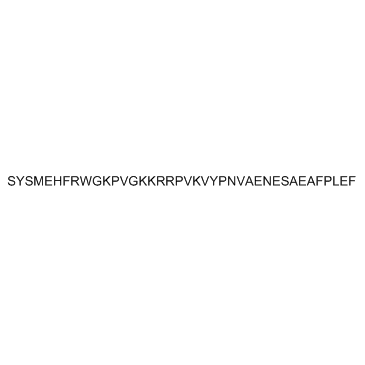ACTH (1-39) (mouse, rat)

ACTH (1-39) (mouse, rat) structure
|
Common Name | ACTH (1-39) (mouse, rat) | ||
|---|---|---|---|---|
| CAS Number | 77465-10-2 | Molecular Weight | 4582.23 | |
| Density | N/A | Boiling Point | N/A | |
| Molecular Formula | C210H315N57O57S | Melting Point | N/A | |
| MSDS | Chinese USA | Flash Point | N/A | |
| Symbol |


GHS07, GHS08 |
Signal Word | Warning | |
Use of ACTH (1-39) (mouse, rat)Adrenocorticotropic Hormone (ACTH) (1-39), rat is a potent melanocortin 2 (MC2) receptor agonist. |
| Name | Adrenocorticotropic Hormone (ACTH) (1-39), rat |
|---|---|
| Synonym | More Synonyms |
| Description | Adrenocorticotropic Hormone (ACTH) (1-39), rat is a potent melanocortin 2 (MC2) receptor agonist. |
|---|---|
| Related Catalog | |
| Target |
Melanocortin 2 receptor[1] |
| In Vitro | ACTH 1-39 at concentrations of 100-400 nM has no toxic effect on neurons, while ACTH provides protection from excitotoxic neuronal death induced by glutamate (100 μM), NMDA (1 mM), AMPA (50 μM), and kainate (25 μM). ACTH at 400 nM provides substantial protection in each case. ACTH at either 200 or 400 nM protects neurons from quinolinic acid (25 μM). There is also protection by ACTH from cell death induced by 2 μM H2O2, which gives rise to reactive oxygen species (ROS), with significantly more protection at 400 nM ACTH compared to 200 nM. ACTH gives modest protection against rapid release of nitric oxide (NO) by NOC-12 but not slow release by NOC-18. ACTH (200 or 400 nM) protects neurons from cytotoxic effects of staurosporine (10-20 nM), a classic inducer of cell death via apoptosis. ACTH reduces cell death from 80% to 55%[1]. |
| In Vivo | The icv injection of ACTH significantly reduces cumulative food intake over the observation period compared with the saline/IgG group. The injection of ACTH Ab into the PVN abolishes the anorexigenic effect of ACTH. Infusion icv of ACTH significantly decreases cumulative food intake in rats that receive α-MSH Ab into the PVN and ACTH icv, and food intake is as low as in the group treated with ACTH icv and IgG into the PVN. Injection of either ACTH Ab or α-MSH Ab into the PVN significantly increase cumulative food intake compared with IgG-treated animals; the combined application of both Ab’s do not increase food intake further[2]. |
| Animal Admin | Rats[2] Male Wistar rats (weight range 225-250 g at purchase) are used throughout the study. Animals receive a PVN application of ACTH Ab (2 μg/rat) or IgG (2 μg/rat); administration of either ACTH (1 nM/rat) or saline icv is performed 5 min later[2]. |
| References |
| Molecular Formula | C210H315N57O57S |
|---|---|
| Molecular Weight | 4582.23 |
| Symbol |


GHS07, GHS08 |
|---|---|
| Signal Word | Warning |
| Hazard Statements | H302-H312-H332-H351 |
| Precautionary Statements | P280 |
| Personal Protective Equipment | Eyeshields;full-face particle respirator type N100 (US);Gloves;respirator cartridge type N100 (US);type P1 (EN143) respirator filter;type P3 (EN 143) respirator cartridges |
| RIDADR | NONH for all modes of transport |
|
Endogenous ACTH, not only alpha-melanocyte-stimulating hormone, reduces food intake mediated by hypothalamic mechanisms.
Am. J. Physiol. Cell Physiol. 298 , E237-E244, (2010) ACTH and alpha-melanocyte-stimulating hormone (alpha-MSH) are both consecutively processed from proopiomelanocortin (POMC), which is synthesized in hypothalamic arcuate neurons innervating the paraven... |
|
|
ACTH (Acthar Gel) Reduces Toxic SOD1 Protein Linked to Amyotrophic Lateral Sclerosis in Transgenic Mice: A Novel Observation.
PLoS ONE 10 , e0125638, (2015) Amyotrophic lateral sclerosis (ALS) is a neurodegenerative disease with a complex etiology and pathology that makes the development of new therapies difficult. ACTH has neurotrophic and myotrophic eff... |
| Serine, O-amino-, methyl ester, hydrochloride (1:1) |
| Methyl O-aminoserinate hydrochloride (1:1) |